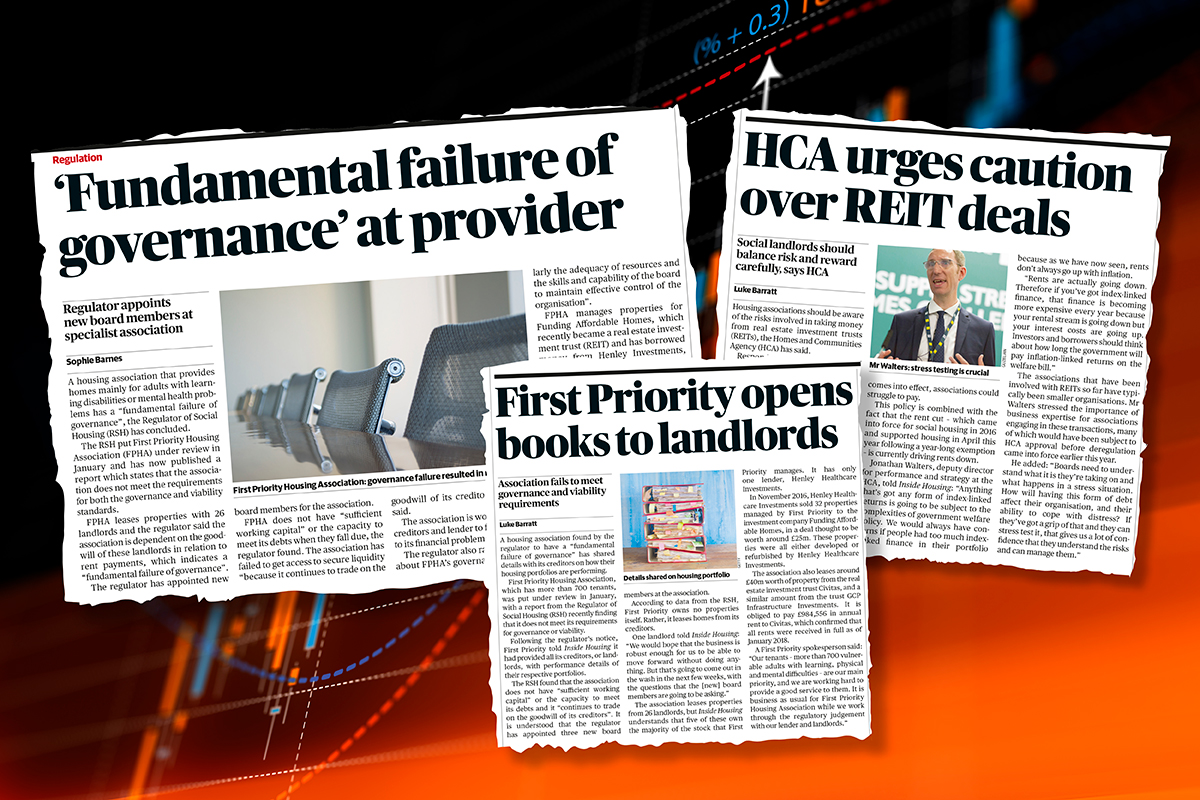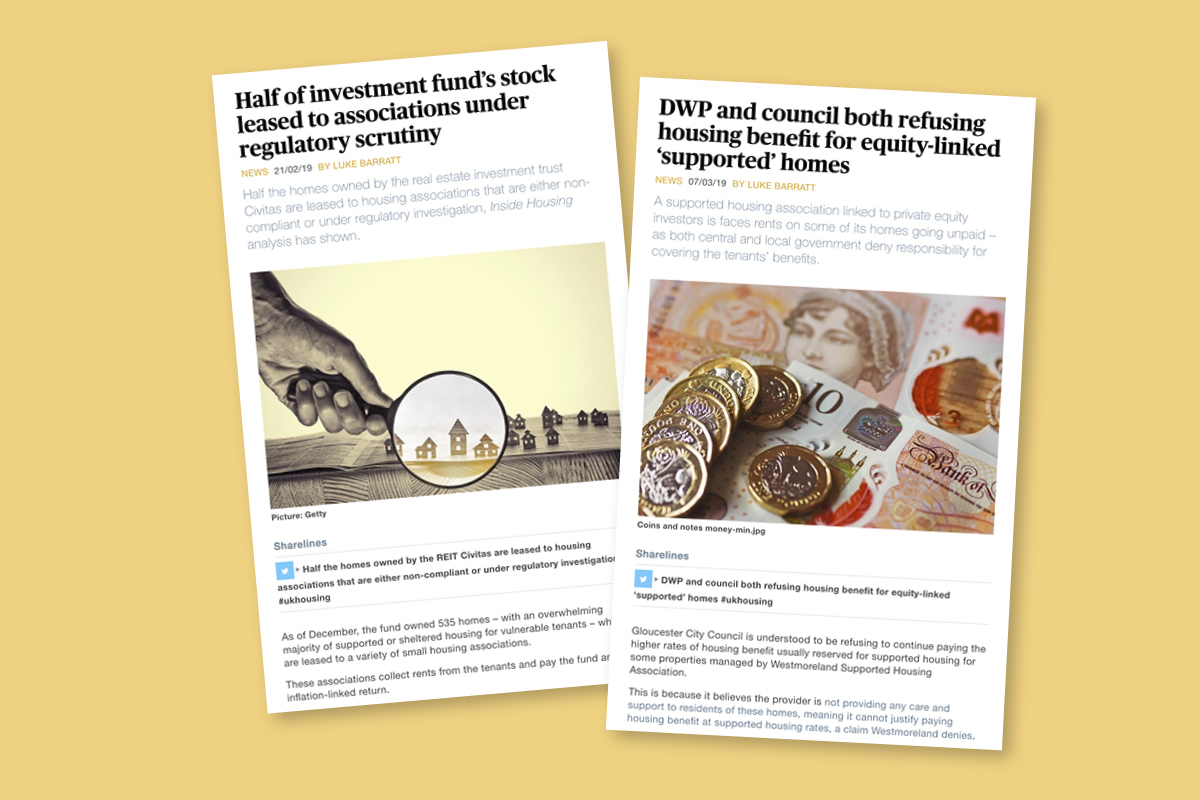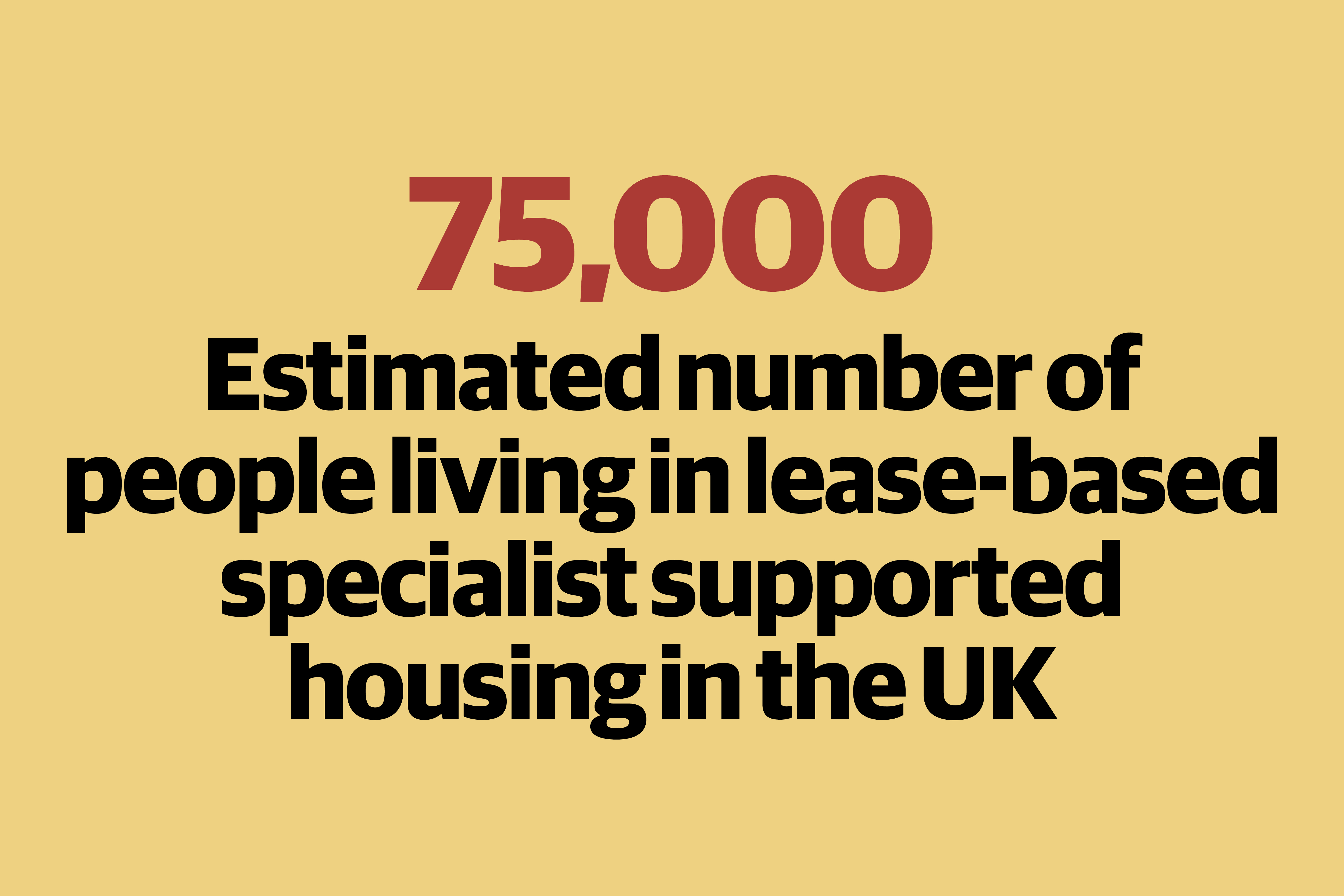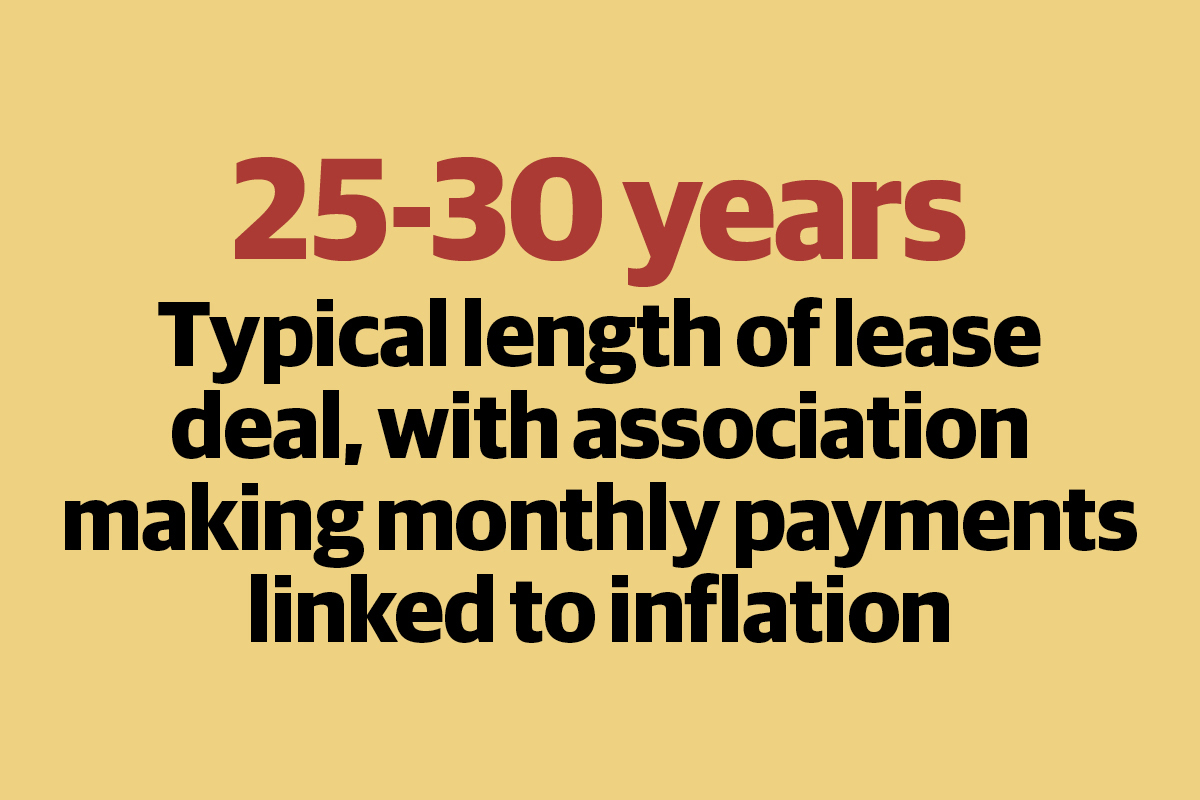You are viewing 1 of your 1 free articles
Private finance and supported housing: an investigation
The rapid rise of commercial investors funding housing for vulnerable tenants has piqued the concern of the regulator. Luke Barratt finds out why it is so controversial and what can happen when things go wrong. Illustration by Charlie Davis
Housing for people with serious mental illnesses is expensive.
Landlords that provide specialist supported housing (SSH) are permitted by government to charge far higher rents than for other social tenures, all paid by the taxpayer through housing benefit. These are often far in excess even of market rents in the area.
But what if all that extra public money isn’t being spent on providing vital care to extremely vulnerable tenants?
This is the story of what can happen when the private sector funds services that many people argue should be the state’s responsibility. And of the risk to the organisations and tenants when things go wrong.
In Gloucester, the council has accused one SSH provider – Westmoreland Supported Housing Association – of claiming money for care it did not provide.
The housing association, which is invariably small, gets to grow and the investor gets a steady rate of income straight from the taxpayer via housing benefit. The aggregator walks away with a tidy profit
Westmoreland denies the accusation. However, the association is under intense financial pressure, as are a number of its peers. The regulator wrote to around 30 similar associations seeking reassurance about their businesses in May last year.
Here’s how it works. A small coterie of developers, known as ‘aggregators’, are central. An aggregator acts as a middleman, buying an ordinary home on the street and adapting it for use as SSH. It then strikes a lease deal with a willing housing association, meaning the association is obliged to make monthly payments linked to inflation, typically for 25 to 30 years.
Then it sells the home on – lease and all – to an investor at a profit.
The housing association, which is invariably small, gets to grow and the investor gets a steady rate of income straight from the taxpayer via housing benefit. The aggregator walks away with a tidy profit.
Over the past year, the English regulator has become more and more interested in this sub-sector and has investigated a number of these housing associations. It has made judgements on four of them, declaring them all non-compliant with its standards. And last year, one of them – First Priority – nearly went bust.
Nevertheless, the associations have continued to grow, with one estimate by the real estate investment trust (REIT) Civitas putting the total number of vulnerable adults living in leased SSH at around 75,000. Funds have continued to lease homes to at least one of the non-compliant organisations – Inclusion Housing – despite the regulatory judgements. Why?
Jonathan Walters, deputy director of strategy and performance at the Regulator of Social Housing (RSH), tells Inside Housing: “These funds have a lot of money to deploy and they need to deploy that money. It’s in their mandate. They can’t just hang on to it.”
For investors, the deals look good on paper. SSH rents are unusually high, because they are exempt from the government’s limitations on rents for social housing. This makes it easier for the investors – which include private equity firms such as Henley Group, or publicly listed REITs like Civitas and Triple Point – to make returns for their shareholders.
For those shareholders, this sounds great. One investment advisor tells Inside Housing: “The market is really hungry for yield. With interest rates so low, with other yielding assets so low, anything risk-free out there gives you a next-to-nothing return.
Firms such as Henley and Civitas describe themselves as ethical funds, making them more attractive to a certain class of investor
“So if someone comes to you and says, ‘Government-backed income, 25 years, oh, and guess what? It’s inflation-proof and it’ll give you a 5% yield,’ what’s not to like?”
Furthermore, funds like Henley and Civitas describe themselves as ethical funds, making them more attractive to a certain class of investor with a social mandate.
Mr Walters, however, says the pension funds and high net worth individuals who typically buy shares in these funds should still exercise caution.
He adds: “I don’t know whether the people who are investing money in those funds always fully understand the issues. We want to make sure people understand the risks in the round associated with investing in these types of organisations.”
Problems have arisen when the housing association can’t afford its lease payments. First Priority, for example, agreed to pay more money in lease payments than it was even receiving in rent for some homes.
This, as Inside Housing revealed last year, was the main reason it almost became insolvent, leaving some investors having to accept reduced payments.
Neil Thorneycroft, former interim finance director at First Priority, who was brought in shortly before the regulator’s involvement to help address some of the emerging issues, tells Inside Housing that councils often don’t end up paying the housing benefit they’ve agreed to.
“The trouble is,” he says, “the people who commission it aren’t the people who dole out the housing benefit.”
Mr Thorneycroft explains how the investor would agree a rent with the local authority, which commissions the care and pays the rent. This rent is high enough to cover their shareholders’ returns, but then the same council’s housing benefit department would balk at the cost and provide a lower amount, or sometimes nothing at all.
Rents throughout this sub-sector are extremely high. Comparing similar homes on property websites shows that they are in some cases three times commercial rent level, and all paid by the taxpayer.
Sunil Wickremeratne owns Exclusive Care Limited, which has signed some of these lease deals. Although he previously delegated the running of the business, he has become more hands-on after realising what kind of deals his company was signing up to.
He says that every example he has seen has provided the aggregator with a hefty dividend of at least 9%.
Mr Wickremeratne shows Inside Housing a sample rent schedule from one provider, Chrysalis Housing, which allocates £68,900 just for lease payments from the total rent of £99,747 annually. This would mean the investor receiving 69% of the housing benefit being provided by the council.
“What are we paying for?” Mr Wickremeratne asks. “We’re paying three times the market rent for these properties. Are they specialist-built buildings that have lifts, that have soft walls that have been built specifically for their needs? No, they’re not. They are very average houses.”
A rent schedule for a home owned by Henley and leased to Westmoreland, which was declared non-compliant last month (February), tells a similar story: £39,432.71, 59% of the total annual rent of £66,654.26, is set aside for lease payments.
What is a REIT?
A real estate investment trust (REIT) is a company that raises money by issuing shares on the stock market and uses it to buy up property in order to raise income and provide a dividend to its shareholders. REITs generally aim to provide a 5% return to investors.
They are exempt from corporation tax on any profits they derive from their property rental businesses.
REITs have been investing in other areas of real estate for decades but have only become involved in social housing since 2016.
In general, the REITs that have launched in the sector have bought properties, repurposed them to be used as supported housing, and leased them to housing associations that own very few homes themselves at levels of rent linked to inflation.
Mr Thorneycroft says that high rents were “definitely” part of the reason that First Priority’s weren’t being paid by the council and suggests that these rents came about “because of the way it’s financed”.
One expert suggests that some of these housing associations may only exist in order to claim the higher rate available from the taxpayer for SSH.
Mr Wickremeratne goes further: “Commercial property investment companies are seeing the national health, the taxpayer, the public exchequer as just ones that can be absolutely fleeced.”
Andy Brandon, managing director of Henley Group’s aggregator arm, Henley Social Investments (HSI), disputes this. “What apparently looks like a high rent, there are reasons for that, such as a three-bed house being required for a single tenant, whereby the rent will reflect the size of the property,” he tells Inside Housing.
“It’s an inefficient development process because of the granularity of the developments and because the needs are so tailored. What we need on top of the cost is a standard developer’s margin.”
Asked what this margin is, Mr Brandon says: “It’s a standard industry development margin. There are no excessive profits to be made in buying, renovating and then selling these properties.”
A spokesperson for the REIT Triple Point, meanwhile, argues that the homes are “often both better for tenants and cheaper than traditional alternatives such as residential care”.
Figures from the regulator reveal that some other housing associations with similar business models to First Priority have similarly high void rates
Another problem at First Priority, according to Mr Thorneycroft, was the high number of empty homes, or ‘voids’, where no housing benefit was being paid but the association still owed lease payments to its investors.
Voids, according to experts in SSH, are almost inevitable.
Mr Wickremeratne tells Inside Housing about a deal he signed with Westmoreland and Henley where he agreed to take on the void risk on a five-bed home.
“We put two individuals in: one in a standalone converted annex and one into the house,” he recalls. “In theory, [we thought] we’ll get three other people into the house and it’ll all be fine. The individual went into the house, [and] his behaviour escalated to quite an extreme level.
“He was a young man who would go to college but he was a big, big young man. His behaviour escalated in such a fashion that he started biting. He would bite women more than males. And literally, the care workers had to have protective guards up their arms.”
The council told Exclusive Care that it couldn’t put any more people in the home because it wasn’t safe. As a result, Mr Wickremeratne says, the home has three voids and Westmoreland and Henley are chasing him for about £97,000.
Meanwhile, figures from the regulator reveal that some other housing associations with similar business models to First Priority have similarly high void rates, making their margins even tighter.
And when margins are tight, risks are magnified.
Last summer, a Westmoreland tenant, Hayden Daniels, took his own life.
Mr Daniels lived in a home in Gloucester owned by Henley and leased to Westmoreland.
The council says that Westmoreland was claiming money for care and support on this home and others but not providing an agreed level of care to its vulnerable tenants.
In a statement made to the council’s investigatory team three months after Mr Daniels’ death, Chris Maitland, his housemate, said: “We used to get support but from about August of 2017 I have not received any support.”
A spokesperson for Westmoreland reveals that the previous care provider ceased trading in 2017. They tell Inside Housing: “The support provision was not recommissioned by either the city council or county council. Westmoreland continued to provide housing management and support to the tenants with contributions from other local service providers.”
In a witness statement submitted to Gloucestershire Coroner’s Court, a Dr Khalid from the Gloucester-based Aspen Medical Practice said that Mr Daniels had “a long history of mental health problems”, including alcohol abuse, “suicidal ideations” and depression.
The doctor added: “In March 2018, it seemed that he was drinking again and he was worried about this and that drinking a large amount of alcohol might get him into trouble.”
According to the council and Mr Maitland, however, Mr Daniels did not receive the care and support he was entitled to between the time he started drinking again and the time of his death.
There is no suggestion that Westmoreland or Henley are in any way responsible for Mr Daniels’ death.
“I went back on the drink and tried to take my life. [My care worker] tried to see me. He banged the door down and got the ambulance. If he hadn’t been there, I wouldn’t be here”
People with addictions of various kinds are common in SSH. Inside Housing spoke to another SSH resident with a history of alcohol abuse, who reveals how important care and support can be.
He told Inside Housing: “I went back on the drink and tried to take my life. [My care worker] tried to see me. He banged the door down and got the ambulance. If he hadn’t been there, I wouldn’t be here.”
Unexpected deaths and serious injuries in the SSH sector as a whole have grown over the past few years. Figures obtained from the Care Quality Commission by BBC Breakfast and shared with Inside Housing reveal that unexpected deaths rose from 56 in 2010 to 378 in 2018. Serious injuries, meanwhile, went from 29 to 808.
Because we don’t have figures for the number of homes in this sub-sector, it’s difficult to tell whether these deaths and injuries have grown proportionately to the growth in the number of homes or not.
Richard Graham, MP for Gloucester, tells Inside Housing: “The tenants, almost by definition, of supported housing, are not the people best equipped to look into what providers are supposed to provide and monitor it and complain.”
Mr Graham, who was involved in the investigation, explains that through various different routes, the council was able to determine that the agreed level of care was not being provided.
He adds: “What you’ve got is a system where one side of the operations is buying up cheapish property as quickly as possible, turfing out the tenants and then bidding for supported housing contracts, which hugely enhances their yield without doing a great deal to provide that support.”
Gloucester City Council only investigated Westmoreland’s care provision after a resident tip-off. Accusations of care not being sufficiently provided are not unique to the equity-linked sub-sector – but there are aspects of the model that mean it is particularly vulnerable to it.
One expert tells Inside Housing that cutting back on care costs is “inevitable” when these associations are under so much pressure to pay investors.
According to Mr Thorneycroft, this was never an option for First Priority. “If we’d cut back elsewhere, we could have [continued to pay investors] but we never considered not providing care and support,” he says.
Investors don’t appear to have paid much mind to the regulator’s concerns.
Mr Thorneycroft explains why he thinks the associations do not appear to have slowed down either: “It was just the [aggregators], I think. It was just business for them. They thought First Priority could take it, I assume. But that was it. The properties just kept coming. In the end, we were saying, ‘We don’t want any more properties.’
“They agreed in the end to stop. But it was a bit like stopping an oil tanker.”
Like many of the lease-based housing associations, Westmoreland has grown incredibly quickly in recent times
Also illuminating are the comments of a social housing professional brought in temporarily as a consultant to review Westmoreland’s business, long before the regulator was aware of any problems.
They tell Inside Housing: “The post would come and you’d get a bundle of leases. You’d get an email saying ‘this property’s been handed over’, but no one’s been involved in the handing-over process. People didn’t know the property was coming. There were all these leases in [the chief executive’s] office and he was going through them one by one.
“I was going to ask, ‘Have you ever looked at a lease and said, I’m not paying that, that’s out of order? Or, I don’t like those terms, and sent it back?’ I suspect the answer would have been ‘no’.”
Westmoreland says that the chief executive at that time – John Finney – is no longer “involved in the running” of the organisation and that it is “not able to comment on perceptions of [his] actions”.
Mr Finney himself adds: “My involvement in WSHA ended almost two years ago and I am no longer involved with WSHA and stepped down from the board on my retirement.
“I firmly believe it is important to allow the new board and regulator to work together without the distraction of commenting on speculation.”
Like many of the lease-based housing associations, Westmoreland has grown incredibly quickly in recent times. Until investors began to take interest, it was a family-run business with a handful of properties. Today, it manages 1,379 homes in 107 local authorities.
Another expert comments: “These are organisations that don’t have the governance or the staffing structures or the financial strength in depth. They are simply relying on lease-based income and I think it’s irresponsible to be pushing organisations to grow at that speed.”
The chair of Westmoreland’s board, John Russell, was also the chair of Fairhome, an aggregator that arranged deals between the housing association and investment funds.
In its judgement on Westmoreland, the Regulator of Social Housing described this as an “inherent conflict of interest”.
Indeed, concerns about conflicts of interest between aggregators and housing associations are a repeated theme.
First Priority, as Inside Housing previously revealed, was set up by Omar Al-Hasso, who also founded the aggregator HSI.
On cases like these, Mr Walters notes: “The board would need to be really clear that the aggregator wasn’t trying to exercise control over it.”
Although these specific problems are common, the fundamental issues with the model are more worrying.
Regulatory judgements in England explained
The Regulator of Social Housing publishes regulatory judgements for all providers owning 1,000 or more social housing homes.
These judgements set out whether the provider is complying with the regulator’s governance and financial viability standards.
The regulator carries out an assessment either through a scheduled in-depth assessment, or reactive engagement (in which the regulator acts following information about a provider).
It then awards the provider a rating from one to four for financial viability (V) and a separate rating from one to four for governance (G).
Providers must score two or higher in both categories to be judged as complying with the standards.
As providers have increasingly taken on more risk to cross-subsidise social and affordable housing delivery through market-facing activity, the regulator has changed a number of associations’ viability ratings from V1 to V2.
The regulator often categorises this kind of regulatory action as ‘regrades’ rather than downgrades. Click here to read more.
Key to ratings:
V1/G1: Compliant
V2/G2: Compliant
V3/G3: Non-compliant and intensive regulatory engagement needed
V4/G4: Non-complaint, serious failures, leading to either intensive regulatory engagement or the use of enforcement powers
Rating straplines in full:
Governance ratings:
G1: The provider meets our governance requirements.
G2: The provider meets our governance requirements but needs to improve some aspects of its governance arrangements to support continued compliance.
G3: The provider does not meet our governance requirements. There are issues of serious regulatory concern and in agreement with us the provider is working to improve its position.
G4: The provider does not meet our governance requirements. There are issues of serious regulatory concern and the provider is subject to regulatory intervention or enforcement action.
Financial viability ratings:
V1: The provider meets our viability requirements and has the financial capacity to deal with a wide range of adverse scenarios.
V2: The provider meets our viability requirements. It has the financial capacity to deal with a reasonable range of adverse scenarios but needs to manage material risks to ensure continued compliance.
V3: The provider does not meet our viability requirements. There are issues of serious regulatory concern and, in agreement with us, the provider is working to improve its position.
V4: The provider does not meet our viability requirements. There are issues of serious regulatory concern and the provider is subject to regulatory intervention or enforcement action.
The regulator’s judgement on Inclusion was a watershed moment. Rather than picking up on individual problems at the organisation, it attacked the business model itself, targeting a housing association seen by many as the best-run in this sub-sector.
It revealed the worst-case scenario if rents are too high, saying the association was relying on being able to renegotiate lease deals with investors if the market turned against it. If this fails, it said, it risked insolvency.
The judgement added: “This could result in the potential loss of the homes from the regulated sector, with inadequate consideration of the rehousing needs of the vulnerable client group housed.”
Paul Bridge, chief executive of Civitas, responds: “When structured to meet fundamental need this represents stable housing that should remain within the social housing sector in the long term.”
Mr Walters comments: “If a traditional housing association were to do leases, which a lot of them do, that’s not particularly a problem. When it’s your only source of financing, it’s all you’ve got and you haven’t got much cash on your balance sheet and the lease costs are going up for 20 or 30 years linked to inflation then that’s when it raises questions on the extent to which it is sustainable as a model.”
“You want a sector that doesn’t rely on these arrangements? Get some public money into them. Where’s the grant funding?”
One expert puts it in stark terms: “The lease payments are index-linked and the income isn’t. If you look at a longer timescale, it is likely, indeed probably pretty much certain, that the gap between income and expenditure will widen, so that at some point it will become not viable.”
Asked about what would happen if a housing association was no longer able to meet its lease commitments, a source at one fund stressed that the government currently pays 100% of the rents and if that were ever not the case a renegotiation would be possible.
Housing benefit agreements are five years long but these lease deals are generally between 25 and 30 years, meaning renegotiations with the local authorities are on the horizon.
The investment advisor who said the offer was initially attractive asks: “What is the risk that one day the government realises it’s effectively paying inflation-linked income to public or private equity-backed vehicles and therefore, as the public purse is ever-stretched, that becomes politically the wrong thing to do and there has to be a negotiation?”
As for alternatives, Phil Shanks, chief executive of supported housing association Partners Foundation, tells Inside Housing: “You want a sector that doesn’t rely on these arrangements? Get some public money into them. Where’s the grant funding?
“If the regulator is so concerned about sustainability of the supported living sector, get £1bn out of the affordable homes budget and buy the houses! Take the risk out of it.”
Even Henley’s Mr Brandon accepts that the cost to the taxpayer would be lower if the government were to grant fund this housing directly, rather than continuing to allow housing benefit to take the strain.
Whatever the solution is, the risk of disruption to people’s care is all too obvious and the regulator has already warned that SSH homes could be lost to the sector if housing associations are not more cautious.
While debates are ongoing, the sub-sector continues to grow. If something is going to change, it needs to change soon.
Update at 3pm on 26.3.2019
The original story carried a reference to John Russell being chair of Westmoreland and Fairhome "during this entire period". In fact, Mr Russell was only chair of both organisations from 8 June 2017 to 29 January 2019.
Fairhome has also disputed the accuracy of a statement attributed to Neil Thorneycroft which claimed it had sought to put a board member on the First Priority board. Fairhome firmly denied this and the statement has been removed.















